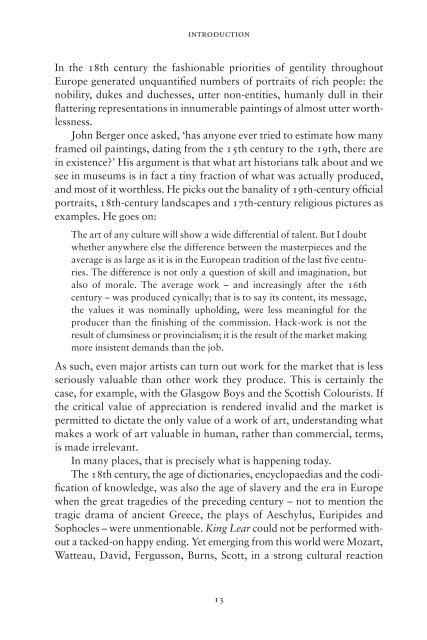Arts of Independence by Alexander Moffat and Alan Riach sampler
ALEXANDER MOFFAT and ALAN RIACH take a hard look at the most neglected aspect of the argument for Scotland’s distinctive national identity: the arts. Their proposition is that music, painting, architecture and, pre-eminently, literature, are the fuel and fire that makes imagination possible. Neglect them at your peril. For Moffat and Riach, jobs, health and trade are matters of material fact that need to be enlivened by imagination. How can we organise society to help us approach what the arts have to give. Why have we been so poor at representing our arts comprehensively, both within Scotland and internationally? What can be done? How might things be different? The arts are of paramount importance in the modern world. Moffat and Riach take the argument out of the hands of politicians and economists and beyond the petty squabbles of party politics.
ALEXANDER MOFFAT and ALAN RIACH take a hard look at the most neglected aspect of the argument for Scotland’s distinctive national identity: the arts. Their proposition is that music, painting, architecture and, pre-eminently, literature, are the fuel and fire that makes imagination possible. Neglect them at your peril. For Moffat and Riach, jobs, health and trade are matters of material fact that need to be enlivened by imagination. How can we organise society to help us approach what the arts have to give. Why have we been so poor at representing our arts comprehensively, both within Scotland and internationally? What can be done? How might things be different? The arts are of paramount importance in the modern world. Moffat and Riach take the argument out of the hands of politicians and economists and beyond the petty squabbles of party politics.
- No tags were found...
Create successful ePaper yourself
Turn your PDF publications into a flip-book with our unique Google optimized e-Paper software.
introduction<br />
In the 18th century the fashionable priorities <strong>of</strong> gentility throughout<br />
Europe generated unquantified numbers <strong>of</strong> portraits <strong>of</strong> rich people: the<br />
nobility, dukes <strong>and</strong> duchesses, utter non-entities, humanly dull in their<br />
flattering representations in innumerable paintings <strong>of</strong> almost utter worthlessness.<br />
John Berger once asked, ‘has anyone ever tried to estimate how many<br />
framed oil paintings, dating from the 15th century to the 19th, there are<br />
in existence?’ His argument is that what art historians talk about <strong>and</strong> we<br />
see in museums is in fact a tiny fraction <strong>of</strong> what was actually produced,<br />
<strong>and</strong> most <strong>of</strong> it worthless. He picks out the banality <strong>of</strong> 19th-century <strong>of</strong>ficial<br />
portraits, 18th-century l<strong>and</strong>scapes <strong>and</strong> 17th-century religious pictures as<br />
examples. He goes on:<br />
The art <strong>of</strong> any culture will show a wide differential <strong>of</strong> talent. But I doubt<br />
whether anywhere else the difference between the masterpieces <strong>and</strong> the<br />
average is as large as it is in the European tradition <strong>of</strong> the last five centuries.<br />
The difference is not only a question <strong>of</strong> skill <strong>and</strong> imagination, but<br />
also <strong>of</strong> morale. The average work – <strong>and</strong> increasingly after the 16th<br />
century – was produced cynically; that is to say its content, its message,<br />
the values it was nominally upholding, were less meaningful for the<br />
producer than the finishing <strong>of</strong> the commission. Hack-work is not the<br />
result <strong>of</strong> clumsiness or provincialism; it is the result <strong>of</strong> the market making<br />
more insistent dem<strong>and</strong>s than the job.<br />
As such, even major artists can turn out work for the market that is less<br />
seriously valuable than other work they produce. This is certainly the<br />
case, for example, with the Glasgow Boys <strong>and</strong> the Scottish Colourists. If<br />
the critical value <strong>of</strong> appreciation is rendered invalid <strong>and</strong> the market is<br />
permitted to dictate the only value <strong>of</strong> a work <strong>of</strong> art, underst<strong>and</strong>ing what<br />
makes a work <strong>of</strong> art valuable in human, rather than commercial, terms,<br />
is made irrelevant.<br />
In many places, that is precisely what is happening today.<br />
The 18th century, the age <strong>of</strong> dictionaries, encyclopaedias <strong>and</strong> the codification<br />
<strong>of</strong> knowledge, was also the age <strong>of</strong> slavery <strong>and</strong> the era in Europe<br />
when the great tragedies <strong>of</strong> the preceding century – not to mention the<br />
tragic drama <strong>of</strong> ancient Greece, the plays <strong>of</strong> Aeschylus, Euripides <strong>and</strong><br />
Sophocles – were unmentionable. King Lear could not be performed without<br />
a tacked-on happy ending. Yet emerging from this world were Mozart,<br />
Watteau, David, Fergusson, Burns, Scott, in a strong cultural reaction<br />
13


















